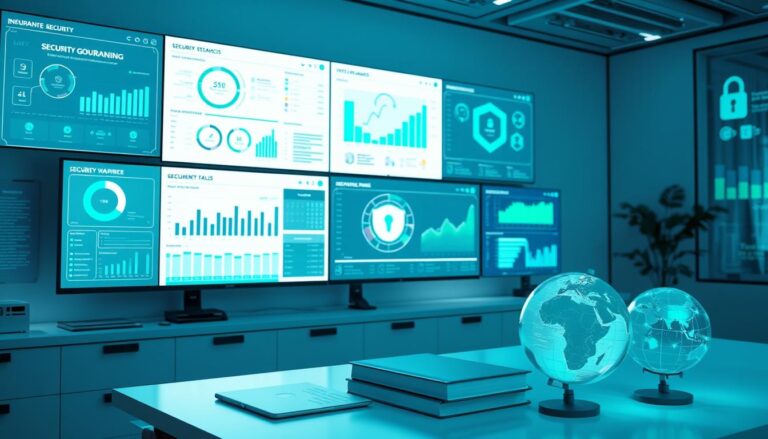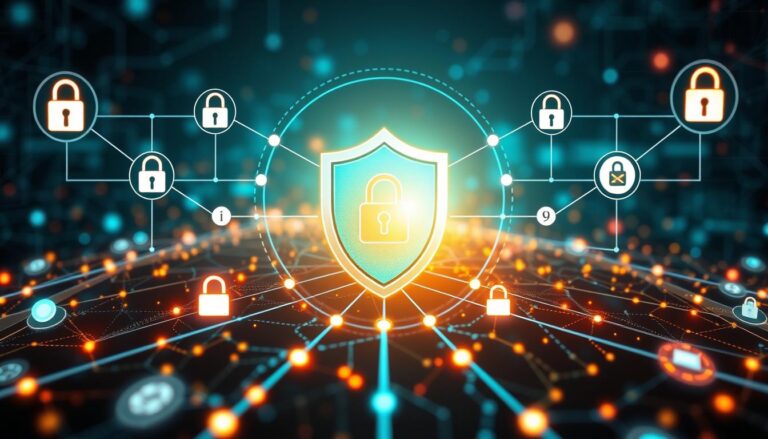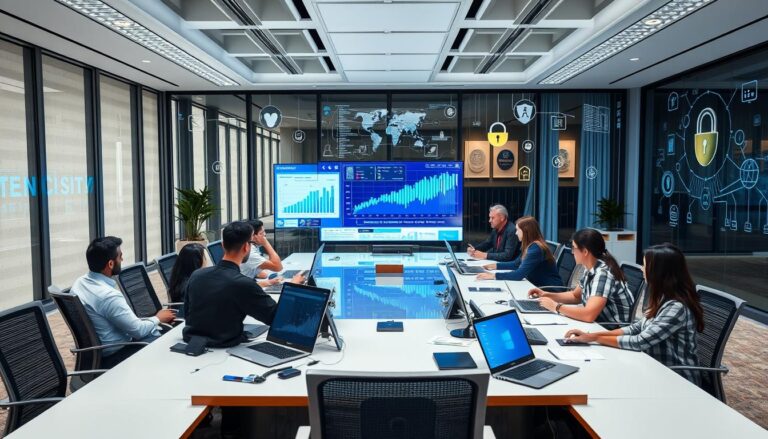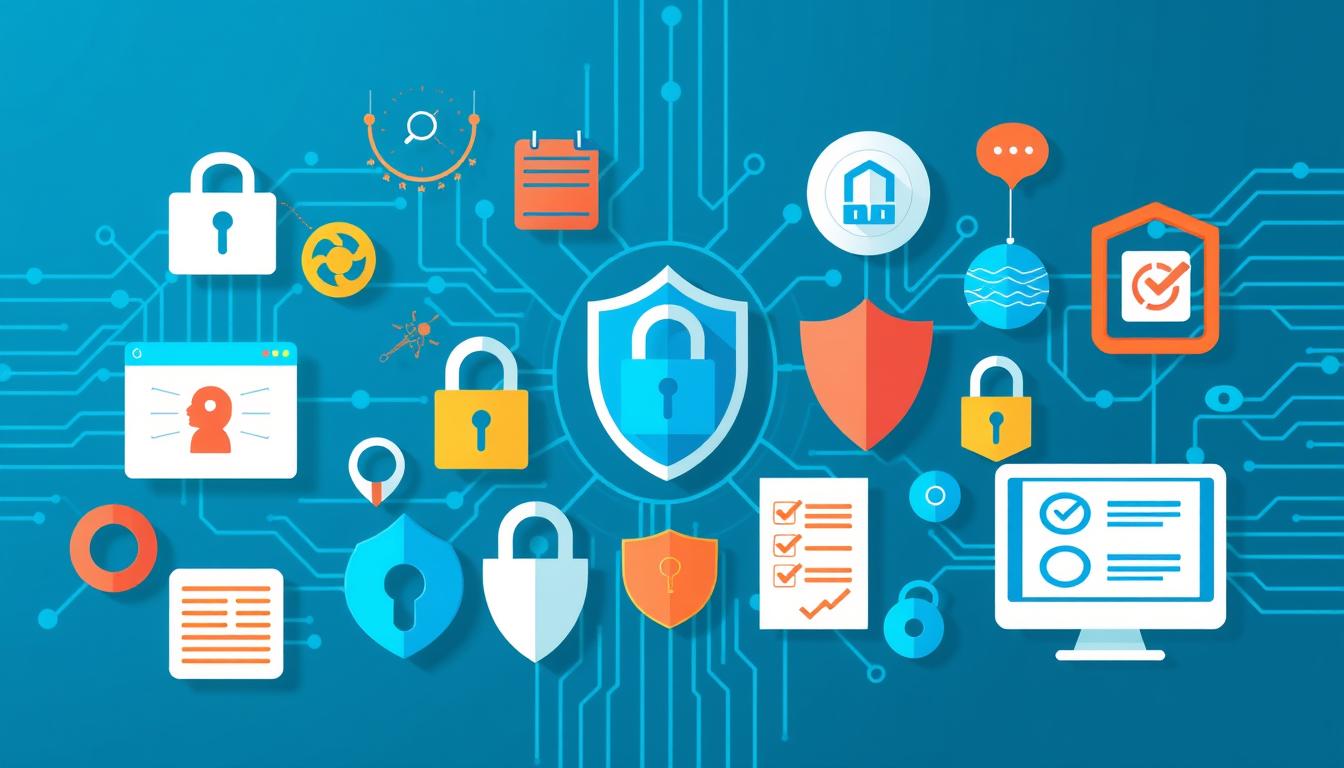
Did you know that 50% of global businesses rely on Governance, Risk, and Compliance (GRC) tools to stay compliant? As the digital world grows, so does the need for tools that fit into your organization’s setup. Strong security governance is key, with a framework of policies and procedures to protect your data.
Organizations using advanced cybersecurity tools see a 30% drop in compliance costs. This shows how important these tools are in keeping your data safe.
The global data governance software market is expected to hit $11.8 billion by 2024. This surge in demand shows the need for effective risk management and data protection solutions. A solid security governance strategy helps you meet regulations and boost your security.
Understanding Information Security Governance
Information security governance is key to protecting a company’s IT assets. It uses structured processes and policies. It involves everyone working together to spot risks.
Creating governance frameworks helps set security policies that match business goals. A good policy keeps information safe and controls who can access it. Agencies like CISA say it’s vital for managing security risks well.
Using automated controls is a big part of good governance. These systems make it easier to handle security and follow rules like BOD 23-01. This helps lower cybersecurity risks by doing thorough risk checks.
Tools like Centraleyes help make governance easier. This makes handling security incidents better. Boards and committees are key in making sure security plans work right.
Doing regular risk checks is important. It helps find security problems and see if rules are followed. Getting the executive team involved makes security plans stronger.
Security governance is more important than ever because of big cyber attacks. Having a solid security plan helps keep the business safe. It makes sure the company follows important rules.
Using frameworks like NIST’s Cybersecurity Framework helps guide security efforts. It has five main parts: Identify, Protect, Detect, Respond, and Recover. This helps keep IT systems safe.
But, finding skilled people for security can be hard. Also, it’s tough to know if security plans are working well. This is because of a lack of good ways to measure success.
In summary, good information security governance makes a company stronger. It makes sure security plans fit with business goals. It helps deal with the changing threats out there.
Importance of Security Governance in Organizations
Having strong security governance in your company is very important. A study showed that 65% of companies faced a big security issue in a year. This shows how urgent it is to have good security plans.
The cost of not having good governance is huge. A data breach can cost up to $4.24 million. Companies that focus on governance are more resilient and trusted by their clients, with 93% seeing its importance.
Companies with good governance see a 50% drop in security problems. This shows how good security plans can really help. Keeping up with governance helps follow important rules like GDPR and HIPAA, with 77% of IT pros agreeing it’s key.
C-suite leaders really get how important security governance is. About 80% of them see it as key to aligning security with the company’s goals. Good governance not only protects data but also makes the workplace safer. Companies that do this well see a 30% increase in employee confidence in data safety.
In short, focusing on governance and security can greatly reduce risks. It makes your company more secure and better at managing risks.
Key Features of Information Security Governance Tools
Good information security governance needs key features to manage risks well. A strong framework has clear policies and procedures for security challenges. About 60% of companies say they follow rules better with a governance system.
Risk assessment is key. Regular checks help cut down on big security problems by 50%. Using tools like firewalls can also lower data breaches by 30%.
Being ready for security issues is important. Plans for dealing with breaches can help recover up to 40% faster. This shows how important it is to have good plans in place.
Training employees is also vital. Studies show a 45% drop in security issues with clear rules. Keeping policies up to date helps avoid problems caused by users.
In the end, a full approach to security governance helps a lot. It includes watching for compliance, assessing risks, and training. This makes your organization safer and saves money on security and following rules.
Top Information Security Governance Tools for 2024
As 2024 gets closer, picking the best governance tools is key for companies wanting to boost their security. Trends show that 65% of companies are focusing on using automated risk management tools. This move greatly improves their security frameworks.
6clicks is a top tool for automating assessments, making governance smoother. Corporater is also a leader, with customized Governance, Risk, and Compliance (GRC) solutions. These are vital for keeping up with different rules. Also, 70% of cybersecurity leaders say having clear risk visibility tools is critical for managing compliance.
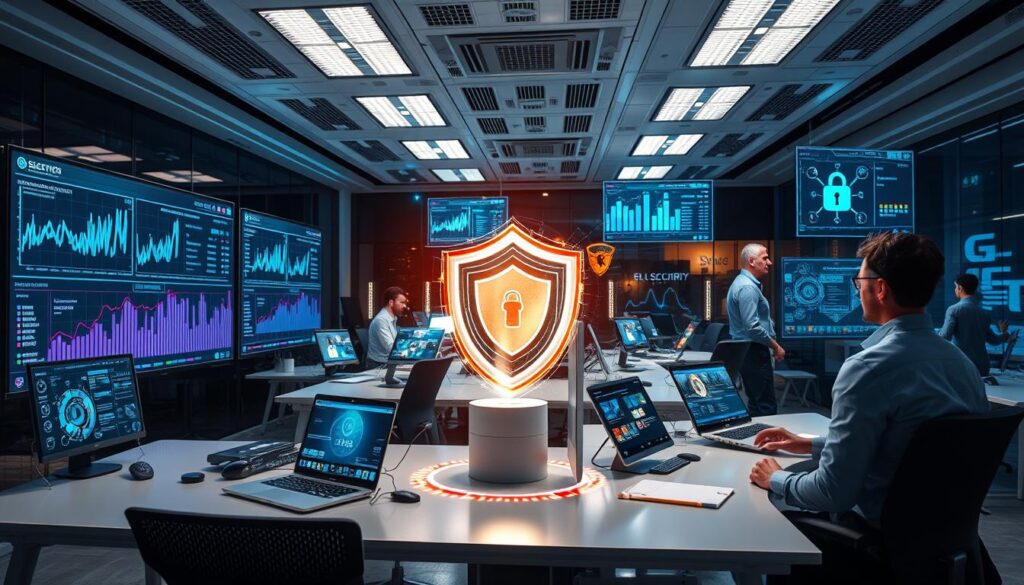
- Digital Guardian is great at protecting sensitive data and handling insider threats.
- Companies using automated vendor risk management systems see a 75% cut in vendor onboarding time.
- Real-time alerts and detailed reports help in responding to incidents faster, with 90% of businesses finding them effective.
- 80% of companies use compliance automation tools, making manual tasks easier.
Here’s a table that shows how effective these leading tools are:
| Tool Name | Key Features | Percentage of Organizations Benefited |
|---|---|---|
| 6clicks | Assessment Automation | 65% |
| Corporater | Tailored GRC Solutions | 70% |
| Digital Guardian | Data Protection & Insider Threat Management | 58% |
| Vendor Risk Management | Automated Onboarding Process | 75% |
| Compliance Automation | Reduced Manual Compliance Burden | 80% |
These tools make security governance easier and help with compliance. With new cyber threats coming up, using the right tools in 2024 is a must for any business.
Risk Assessment Platforms: Enhancing Security Posture
Risk assessment platforms are key to making your organization’s security stronger. They help find and check possible security dangers. This keeps you ready for changes in the security world.
Good risk assessment platforms have strong risk finding, detailed checks, and clear reports. These security improvement tools help you manage threats before they happen. Companies like CyberStrong make tracking and reporting easier, making the whole process smoother.
CyberStrong and similar platforms connect security controls to risks. This helps manage cyber risks in real-time. It also helps plan budgets and use resources wisely by showing risks in money terms.
Today, companies must focus more on cybersecurity because of new SEC rules. Using platforms for ongoing control checks helps keep up with these rules. This way, businesses don’t need to use many products at once.
Using these platforms, companies can make a list of important threats and their possible effects. Keeping this list up to date helps with growth and new challenges. Training employees also helps reduce mistakes that can lead to security problems.
In short, using risk assessment platforms is essential for any company wanting to improve its security. It helps manage threats and follow current rules.
| Feature | Description | Benefits |
|---|---|---|
| Risk Identification | Mechanisms to discover possible risks in operations. | Proactive threat mitigation. |
| Financial Quantification | Ability to turn risks into financial terms. | Informed budget planning. |
| Continuous Control Monitoring | Monitors compliance and risk all the time. | Reduces need for many tools. |
| Executive Dashboard | Real-time view of cyber risk profiles. | Improved communication with management. |
Compliance Monitoring Tools: Staying Ahead of Regulations
Compliance monitoring tools are key for keeping your organization in line with changing rules. They help 80% of companies improve their regulatory alignment. These tools make checking compliance easier and help with reporting, improving governance and risk management.
Keeping up with regulations is tough for over 60% of companies. They face challenges with scattered compliance systems, leading to blind spots. This can cause big problems, costing up to $14.82 million a year in fines and disruptions. Tools for monitoring compliance can help by managing everything in one place and keeping an eye on things in real-time.
Using these tools can also save money. Businesses can cut compliance costs by up to 32%. Almost 50% of compliance experts say manual processes lead to more mistakes. Automated systems cut down on errors, which cause 25% of compliance problems, and make things more efficient. They can also make audit prep 40% quicker, saving time and money.
Here’s a comparison table highlighting the advantages of using compliance monitoring tools:
| Aspect | Manual Compliance Processes | Automated Compliance Monitoring Tools |
|---|---|---|
| Cost Efficiency | Higher costs (35% more) | Up to 32% reduction in expenses |
| Error Rate | Increased likelihood of errors | Reduces human error by automating tasks |
| Audit Preparation Time | Longer preparation time | 40% faster preparation |
| Regulatory Adaptability | Slow response time | 30% faster response to regulatory changes |
| Stakeholder Trust | Lower trust | Enhanced trust through transparency |
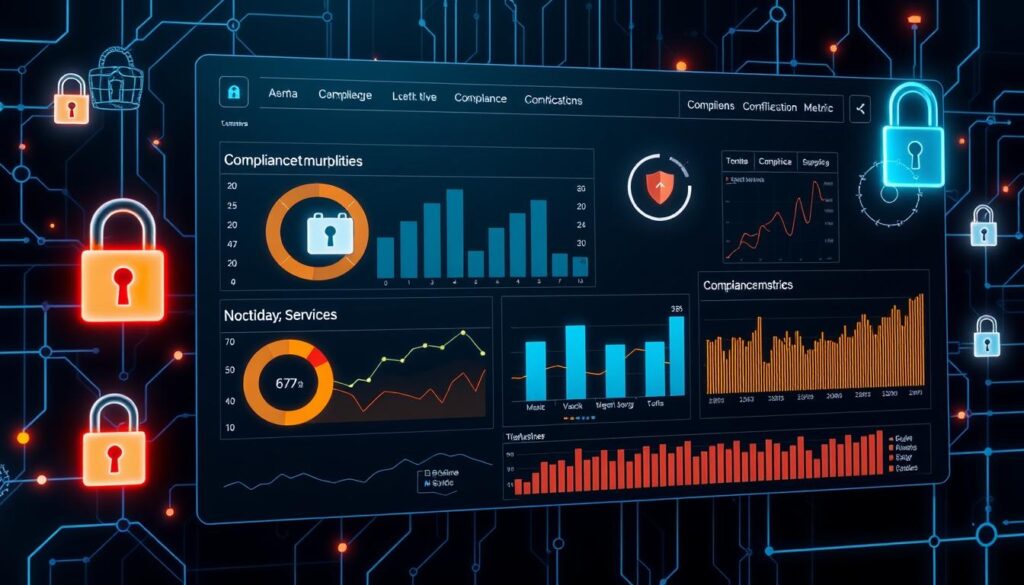
Security Policy Automation: Streamlining Processes
Security policy automation tools are key to better security management in companies. They help create, share, and check security policies automatically. This reduces mistakes and makes sure everyone follows the rules. It’s very important in today’s world, where new threats pop up all the time.
These tools make governance easier. For example, SIEM tools give you instant updates on security issues. SOAR tools let your team act fast on threats, reducing harm.
There are many automation tools to choose from to boost your security. Here are some you might find useful:
| Type of Tool | Description |
|---|---|
| Security Information and Event Management (SIEM) | Provides real-time analysis of security alerts generated by hardware and applications. |
| Security Orchestration, Automation, and Response (SOAR) | Automates response actions to security incidents, improving efficiency. |
| Vulnerability Management | Automates the identification and remediation of vulnerabilities within IT infrastructure. |
| Identity and Access Management (IAM) | Handles automated identity verification and access control processes. |
| Compliance Monitoring Tools | Ensures continuous adherence to regulatory standards through automated checks. |
| Security Configuration Management | Establishes secure baseline configurations to monitor and assess security settings. |
Adding security automation tools to your team can make things run smoother. It lets your security team focus on important tasks, not just routine work. This leads to better security and fewer mistakes, helping your company stay safe.
Governance, Risk, and Compliance (GRC) Tools
GRC tools are key to aligning tech with company strategies. They help manage risks and stay compliant with changing rules. The US has seen big changes in rules, making GRC tools more important for businesses.
MetricStream is a top choice, recognized as a Leader in The Forrester Wave™ for GRC Platforms. It stands out for its AI, Control Insights, and Continuous Control Sensing. These features help keep up with changing rules and spot risks early.
AI in GRC tools is a must, not just a trend. It brings features like alerts and horizon scanning. Tools like AuditBoard and LogicGate make workflows flexible and automated. This makes GRC processes smoother and cuts down on old methods’ flaws.
Cyber threats are on the rise, making GRC tools more critical. Companies need these tools to avoid risks from old ways of working. Tools like CyberStrong give real-time views of security, helping keep data safe.
| GRC Tool | Key Features | Notable Recognition |
|---|---|---|
| MetricStream | AI capabilities, Control Insights, Continuous Control Sensing | Leader in Forrester Wave™ |
| AuditBoard | Automated workflows for audit processes | Market Leader in Audit Management |
| LogicGate | Customizable workflows, flexibility | Gartner Cool Vendor |
| ServiceNow | Integrated GRC solutions, intelligent chatbots | Top-tier GRC platform |
| CyberStrong | Real-time cybersecurity posture | Innovative Cyber Risk Management |
In short, advanced GRC tools are vital for a culture of compliance. They reduce waste and keep you safe from many risks. Knowing how to use GRC tools well helps your company deal with complex rules and keep a strong governance framework.
Cybersecurity Management Software: Enhancing Protection
Cybersecurity management software is key to protecting your organization. It helps detect and handle threats quickly. This is vital as data attacks are getting more common.
Tools like LogicManager help manage compliance with laws like GDPR and HIPAA. They keep an eye on risks all the time. This makes your organization stronger against data breaches.
Using SaaS models makes things easier for big companies. It helps them save money and time. This software also helps set rules for managing risks. It makes your data safer from hackers.
Data Protection Solutions: Safeguarding Sensitive Information
Data breaches can cost companies an average of $4.24 million. This makes it vital to have strong data protection solutions. About 60% of small companies fail after a big data breach. This shows how important it is to protect data to keep businesses running.
Using Data Loss Prevention (DLP) systems can cut data breach risks by half. These tools help companies follow strict rules like GDPR. They also keep sensitive data safe from unauthorized access. Not following these rules can lead to huge fines, up to 4% of a company’s global revenue.
Good information security tools use a layered approach. This includes encryption for data at rest and in transit. Encryption can stop about 93% of unauthorized access attempts. Using advanced tools like SIEM can help find breaches 50% faster, making your company more ready for cyber threats.
Using multi-factor authentication (MFA) can block up to 99.9% of automated cyberattacks. As companies move to hybrid clouds and more endpoints, they need better data protection. This shows the need for a solid data security plan.
The table below shows key features of popular data protection solutions and their impact on information security:
| Data Protection Solution | Key Features | Impact on Data Security |
|---|---|---|
| Digital Guardian | Data-centric protection, real-time monitoring | Ensures compliance and integrity of data |
| IBM Guardium | Vulnerability assessment, compliance auditing | Provides real-time insights for data safeguarding |
| Symantec DLP | Data classification, encryption | Reduces risk of unauthorized access |
| Palo Alto Networks | Network security, automated threat detection | Prevents data breaches from network vulnerabilities |
Using advanced information security tools is not just a good idea. It’s a must for keeping your company’s data safe. By focusing on data protection, you can strengthen your security and keep your stakeholders’ trust.
Conclusion
Implementing strong information security governance tools is key for companies to protect their data. It also helps them follow regulatory standards. As cybersecurity changes, it’s important to use complete governance strategies and solutions.
Using tools for risk assessment, compliance, and data protection boosts your security. Companies that focus on information security governance can handle risks better. They also avoid big financial losses from breaches and build trust with others.
Good information security governance is more than just an IT issue. It’s a big part of corporate governance that needs attention from boards and executives. By linking security frameworks with company goals, you can make a strong environment. This environment can face the many challenges of the digital world.
Source Links
- Top 10 Governance, Risk & Compliance (GRC) Tools
- List of Best Security Governance Tools – DevOpsSchool.com
- The 11 Best GRC Tools for 2024
- Understanding information security governance
- A Guide to Information Security Governance
- Cybersecurity Governance | CISA
- What is Information Security Governance ?
- Unlocking the Benefits of Information Security Governance and Risk Management
- What Is Information Security Governance in Cybersecurity?
- What Is Information Security Governance?
- Security Governance Tools
- The Best 9 Cloud Security Tools of 2024
- Top 16 Cyber Security tools You Must Know in 2025 – Sprinto
- 13 essential enterprise security tools — and 10 nice-to-haves
- CyberSaint | Cyber Risk Management Software & Platform
- IT GRC (Governance, Risk, & Compliance) For Scaling Businesses
- Compliance Monitoring Tools: Ensure Data Safety
- What is Compliance Monitoring? | IBM
- ManageEngine Log360
- Security Automation Tools: SIEM, SOAR, IAM, Configuration Management + More Tools to Ensure IT Security | Puppet by Perforce
- Top 10 Security Automation Tools – Spectral
- AlgoSec | What is Network Security Policy Automation?
- Top 5 Governance, Risk, and Compliance (GRC) Tools and Solutions for 2025
- GRC in Cyber Security
- IT Risk Assessment Software | LogicManager
- What is GRC, and How Does It Enable Cybersecurity? – CDP.com – Leading CDP Industry Resource for Marketing & Sales
- What is GRC? – Governance, Risk, and Compliance Explained – AWS
- Top 12 Types of Data Security Solutions for Protecting Your Sensitive Information
- Data Security and Protection Solutions | IBM
- Information Security Governance Assessment Tool
- Information Security Governance Roles and Responsibilities
